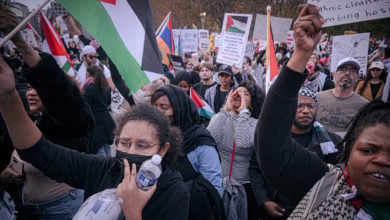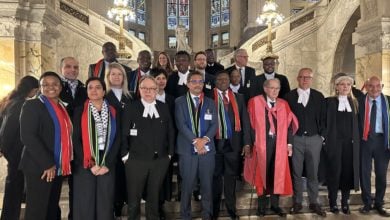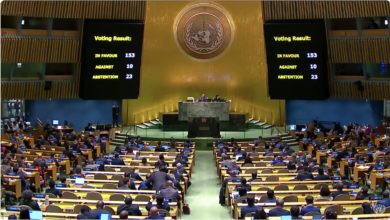The conflict in Yemen has heated up in recent days, with a fresh round of Saudi air strikes targeting Yemeni villages Nov. 27 and battles between Houthi rebel forces and Yemen’s military Nov. 28.
 Buildings burn in Sa’ada, Yemen, following an airstrike carried out by Saudi Arabian forces. |
Yemen, the poorest nation in the Arab world, is experiencing two different conflicts in the north and in the south of the country, only recently unified in 1990.
Starting Nov. 5, Saudi Arabia’s military launched air and artillery attacks on Yemen’s Sa’ada province against Houthi rebels. This action by a U.S. client state in the region represents a major development in the civil conflict, ongoing since 2005.
The Houthis are members of the Zaydi branch of Shi’ite Islam. The majority of the population in the North identify with Zaydism, which is only found in Yemen.
The Zaydi Imamate ruled northern Yemen in a feudal theocracy from the eighth century until it was overthrown by the Republican Revolution in 1962. The revolution ushered in the beginning of capitalist development in the impoverished and underdeveloped nation.
The Yemeni government accuses the Houthi rebels of wishing to bring back theocratic rule; the Houthi leaders claim they oppose the corruption of the central government and only seek more autonomy for their region.
The Saudi government is weighing in on the side of the Yemeni government. Interestingly, during the eight-year civil war that followed the assassination of the imam, Saudi Arabia supported the very royalists that today the Houthis are accused of wanting to restore. In that civil war, Britain and Saudi Arabia, both backed by the United States, provided material aid to the royalists while Egypt sent troops with Soviet material aid to back the republicans.
The conflict with the Houthis has been ongoing since 2005, leading to a major humanitarian crisis with an estimated 175,000 displaced people, according to the U.N. High Commissioner for Refugees. U.N. agencies have charged the Yemeni government forces with torture against people in the north. The government has also been accused of using phosphorus bombs against the population in Sa’ada.
The Yemeni government claims the Iranian government is supporting the Houthi rebels. For its part, Iranian officials have insisted that foreign governments refrain from interfering in the conflict, in an obvious rebuke to the cross-border Saudi attack on Houthi forces.
The allegations against Iran—regardless of whether there is any truth to them—could become a pretext to turn Yemen into an arena for a wider war of U.S.-backed Yemeni and Saudi forces targeting Iran via the Houthi rebellion.
Upheaval in the south
In the south, the Peaceful Southern Mobilization Movement has been leading demonstrations against the central government and calling for southern secession from the north since 2007, raising the flag of the People’s Democratic Republic of Yemen.
Massive demonstrations in southern cities over the summer were brutally attacked by government forces, with many demonstrators jailed. Most recently, armed forces associated with the Southern Movement have attacked Yemeni government security forces, leading to at least one death.
In contrast to the north, southern Yemen was colonized by Britain. The British were eventually forced to withdraw in 1967 by socialist revolutionaries, who founded the People’s Democratic Republic of Yemen. The two Yemens united in 1990, but civil war broke out in 1994 as the south attempted to secede due to dissatisfaction with the domination of the more socially backward, pro-capitalist north. The southern forces were defeated in 1994, and the unification project continued.
Yemen’s President Ali Abdallah Saleh has been in power since 1978. His central government depends on the cooperation of traditional and tribal elements, especially in remote, mountainous regions.
Ever since the end of the 1994 civil war, the Saleh government has pursued economic development through integration into the capitalist globalization process. This has resulted in the destruction of traditional Yemeni economic and social structures, and has led to an increasing gap between the tiny few who have profited from this process and the impoverished majority. Despite widespread poverty, Yemen has natural resources, including oil, and a rich history and culture with potential for tourism.
The Saleh government has allied itself with U.S. interests in the region, cooperating with the United States in fighting Somali “pirates” and collaborating with Washington in the “war on terror.” Al-Qaeda does have roots in Yemen—Osama bin Laden’s family is from the disputed region between Yemen and Saudi Arabia, and a number of Yemenis fought with his organization in Afghanistan.
U.S. imperialists fear that if the Saleh government loses all authority in the remote, undeveloped regions of the nation, those regions might become a base for forces that are not aligned with U.S. interests. They are willing to faintly support Saleh—to the tune of $34 million last year—in order to hold Yemen together and maintain stability in the region, which includes Saudi Arabia as Yemen’s neighbor to the north and east.
Should the Saleh government fail to prevent a socialist-led state from seceding from the south or stop rebel forces from gaining the upper hand in the north, would the United States refrain from more forceful intervention? Anti-imperialists need to be on the alert for developments in this region and steadfastly oppose U.S. intervention, be it through direct military action or traditional proxy forces.






